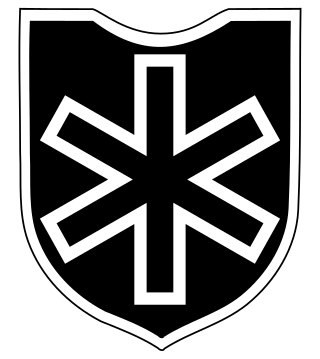Background
After the Wehrmacht took heavy casualties among infantry divisions in the summer of 1944, they started organizing volksgrenadier ("people's grenadier") divisions, which were new infantry divisions with less manpower and equipment, along with a new title to raise morale. Adolf Hitler came up with the name, with volk appealing to German nationalism and grenadier referring to German military traditions. These had fewer soldiers and less heavy equipment than normal infantry divisions, but more automatic weapons (such as the Sturmgewehr 44) and anti-tank weapons (Panzerfaust and Panzerschreck). They also had a shortage of motorized vehicles, relying primarily on horses and to a lesser extent on bicycles. The volksgrenadier formations were put together with young and old conscripts, security troops, former personnel of the Luftwaffe and Kriegsmarine, and, in some cases, they were combined with surviving members of infantry divisions that had been destroyed. The latter received the numbers of the infantry divisions they were combined with, as Hitler wanted to preserve their history, while those that were completely new were generally given a number in the 500 series. Heinrich Himmler and the SS were responsible for overseeing the training of these units, though they remained part of the Wehrmacht.
History
It was established at the Baumholder training camp as the 559th Grenadier Division in the mobilization wave of July 1944, being a replacement infantry division for those that were lost on the Eastern Front. On 9 October 1944 its designation was changed to 559th Volksgrenadier Division, and it had a strength of 8,500 troops. The division was originally assigned to go to the Eastern Front, and was staffed with officers that had combat experience. However, before it could get much training, in the first days of September the division was sent to the west, where it was assembled along with the 3rd and 15th Panzergrenadier divisions and the 553rd Volksgrenadier Division, before reinforcing the German positions in northeastern France.
The division was deployed to assist the 1st Army in the Moselle river area, where the 1st Army and 5th Panzer Army tried to stop the Allied advance from Paris to the Rhine near Metz. It defended Thionville in early September against units of the U.S. 90th Infantry Division. When George Patton's U.S. Third Army paused its advance, the Germans launched a counterattack, with the 559th Grenadier Division and the 106th Panzer Brigade advancing on American positions near Moncel-sur-Seille on 24 September 1944, being held by the Third Army's XII Corps. Although the attack had been preceded by an artillery bombardment, as the division had a full artillery regiment, the U.S. artillery responded with counter-battery fire, and they also received air support from P-47 Thunderbolts strafing the Germans. After several hours of fighting the counterattack by the 559th and 106th had failed, but they did succeed in closing a gap in the German line between the 1st Army and the 5th Panzer Army. On 27 September, the 559th launched another attack, in the forest near Grémecey, and made some progress before American reinforcements from the 6th Armored Division arrived. The XII Corps forced them to withdraw from the area around the end of the month.
The division remained near Chateau-Salins after retreating and was ordered to hold the line there as of early November 1944. American troops broke through its positions and pushed it back, taking Chateau-Salins on 9 November. Even after taking significant losses, the 559th was still considered a capable formation by the German command. In the middle of the month, the remnants of the German 48th Infantry Division were combined with the 559th, which together became a kampfgruppe (battle group). The volksgrenadier division was then moved to Saarlautern near the West Wall, and managed to hold its positions when the U.S. XX Corps began its initial attack starting on 28 November. The 559th took heavy losses in fierce house-to-house fighting while defending Saarlautern from the U.S. 95th Infantry Division, which reached the city center on 3 December. In early January 1945, the division participated in Operation Nordwind, the southern portion of the German offensive that became the Battle of the Bulge. It attempted to capture Lemberg but was stopped by the 100th Infantry Division.
It continued to fight in the battles near the West Wall from January to March 1945, and remained in a salient past the Wall near Saarbrücken at the start of March. American forces spent the first two months of 1945 preparing for an offensive into the Saar–Palatinate, across the Moselle river, to establish bridgeheads along the Rhine at the southern end of the Allied front. Paul Hausser, the commander of Army Group G in the Saar region, requested that the 559th be withdrawn from the West Wall to reinforce the section of the Moselle river from Koblenz to Cochem, which Hitler granted. In mid-March the first units from the division arrived in the Moselle sector, though too late to make a difference in the fighting there.
After the Americans established a bridgehead on the Moselle river and advanced into Saarland, the Germans withdrew to the eastern side of the Rhine. The 559th Volksgrenadier Division was near Mannheim, and was the largest division left in the portion of the Rhine between Mannheim and Wiesbaden. The U.S. 3rd Infantry Division crossed the Rhine in the area near the 559th Volksgrenadier on 26 March 1945. They were initially met with mortar and anti-aircraft artillery fire from the Germans as they prepared to cross to the eastern bank of the river, but American counter-battery fire was effective and the 3rd Infantry was able to cross. They continued facing resistance in the villages and countryside from German troops, engaging in house-to-house fighting. Nonetheless, the 3rd Infantry were able to push the 559th out of the area and secured a bridgehead for the U.S. Seventh Army to cross the Rhine. The division was nearly destroyed in the battle and what was left of it surrendered to the U.S. in Münsingen, Württemberg, in May 1945.

The 6th SS Mountain Division Nord was a World War II mountain infantry division of the Waffen-SS, the military wing of the German Nazi Party, primarily consisting of ethnic Germans along with some Norwegian and Swiss volunteers. It was the only Waffen-SS division to operate in the Arctic Circle.

The Panzer-Lehr-Division was an elite German armoured division during World War II. It was formed in 1943 onwards from training and demonstration troops stationed in Germany, to provide additional armored strength for the anticipated Allied invasion of western Europe. On 4 April 1944, the division was officially designated as the 130th Panzer Division; however, it is usually referred to as the Lehr Division. It was the only Wehrmacht Panzer division to be fully equipped with tanks and with halftracks to transport its mechanized infantry. On several occasions it fought almost to destruction, in particular during Operation Cobra, and by the end of the war in Europe bore little resemblance to the unit that had originally been activated.

The 212th Infantry Division was a German infantry division that fought in World War II. It was destroyed in Lithuania, and reconstituted as the 578th Volksgrenadier Division before being renamed the 212th Volksgrenadier Division.

The 183rd Volksgrenadier Division was a German unit during World War II.

The 272nd Volksgrenadier Division, was a German Army Volksgrenadier division formed following the defeats of the Normandy Campaign in 1944. Composed of men taken from existing Heer (army) units and airmen and sailors retasked to infantry duties, the division fought on the retreating Western Front until it was largely encircled in the Ruhr Pocket in April 1945.
The 564th Volksgrenadier Division was a volksgrenadier division of the German Army during the Second World War that existed from 26 August to 15 September 1944.

The 36th Infantry Division was a German infantry formation of World War II. It was formed in Kaiserslautern on 1 October 1936. During World War II it was mobilized in August 1939, as part of the first wave. It was later reorganized and re-designated the 36th Infantry Division (mot) in November 1940. It was then de-motorized, reorganized and re-designated the 36th Infantry Division on 1 May 1943. The division was destroyed at Bobruysk in June 1944 during the Soviet Operation Bagration. It was reformed on 3 August 1944 as the 36th Grenadier Division and renamed the 36th Volksgrenadier Division in October 1944.

The 45th Infantry Division was an infantry division of the army of Nazi Germany during World War II. Towards the end of the war, the division was reassembled into a second iteration, the 45th Volksgrenadier Division

The 31st Infantry Division was a German infantry division of the Army during World War II. It participated in the invasion of Poland in 1939 then the invasion of France and the Low Countries in 1940. As part of Panzergruppe 2. of Army Group Centre, it was involved in the invasion of the Soviet Union in June 1941. After hard fighting throughout 1941 and 1942 it joined the 9th Army and fought in the Battle of Kursk in July and August 1943. Along with the rest of the 9th Army, the division conducted a fighting withdrawal for the remainder of 1943, during which it sustained heavy casualties. In the early stages of the Soviet Operation Bagration of June to August 1944, the 31st Infantry Division was destroyed, a fate which subsequently befell most of Army Group Centre. The division was officially disbanded on 18 July 1944.

The 256th Infantry Division was a German infantry division in World War II. They formed in August 1939 as part of the 4. Welle (wave). The division was destroyed at Vitebsk in June 1944 during Operation Bagration. The remnants of the division formed Divisions-Gruppe 256 which was assigned to Korpsabteilung H.

The 48th Infantry Division was a German division in World War II.

The Feste Hindersin renamed Gambetta fort by the French in 1919, is a military installation near Metz. It is part of the first fortified belt of forts of Metz and had its baptism of fire in late 1944, when Battle of Metz occurred.
The 361st Infantry Division was an infantry division of the German Army during the Second World War, active from 1943 to 1945. It was redesignated as a Volksgrenadier division in 1944. It saw active service on the Eastern Front when the Soviets launched Operation Bagration, during which it suffered significant losses. It later fought in France before being absorbed by the 559th Volksgrenadier Division on 10 March 1945.

The 211th Infantry Division was a German infantry division of the German Heer during World War II, active from 1939 to 1944.
The LXXXIX Army Corps was an army corps of Germany's Wehrmacht during World War II. It was active from August 1942 until March 1945. Its commander surrendered to United States Army forces on 2 April 1945.
The 549th Volksgrenadier Division was a volksgrenadier infantry division of the German Army during World War II, active from 1944 to 1945. It was formed as the 549th Grenadier Division in July 1944 and became a volksgrenadier division several months later. Fighting on the Eastern Front, it was nearly destroyed in the East Prussian Offensive, with its remnants retreating west and surrendering to American troops at the end of the war.
The 271st Infantry Division was an infantry division of the German Heer during World War II.
The 416th Infantry Division was a German infantry division of World War II.
The 544th Volksgrenadier Division was a Volksgrenadier-type infantry division of the German Wehrmacht during World War II. It was active from July 1944 to May 1945. In the first two months of service, the division was designated 544th Grenadier Division.
The 553rd Volksgrenadier Division was a volksgrenadier division of the German Army during World War II that fought entirely on the Western Front.
This page is based on this
Wikipedia article Text is available under the
CC BY-SA 4.0 license; additional terms may apply.
Images, videos and audio are available under their respective licenses.











